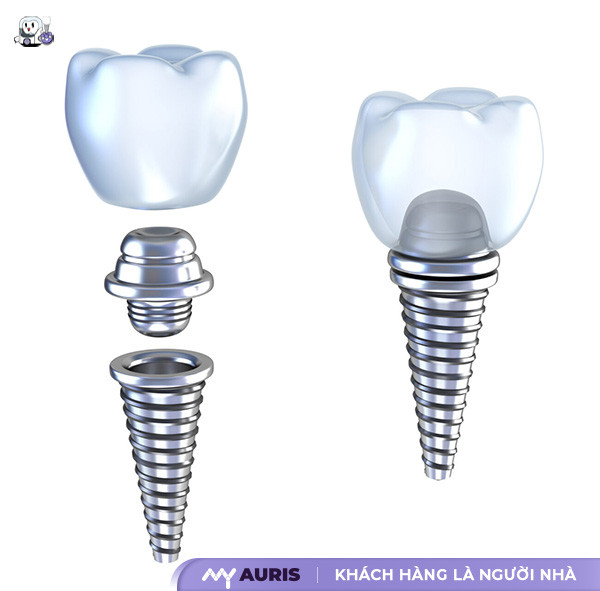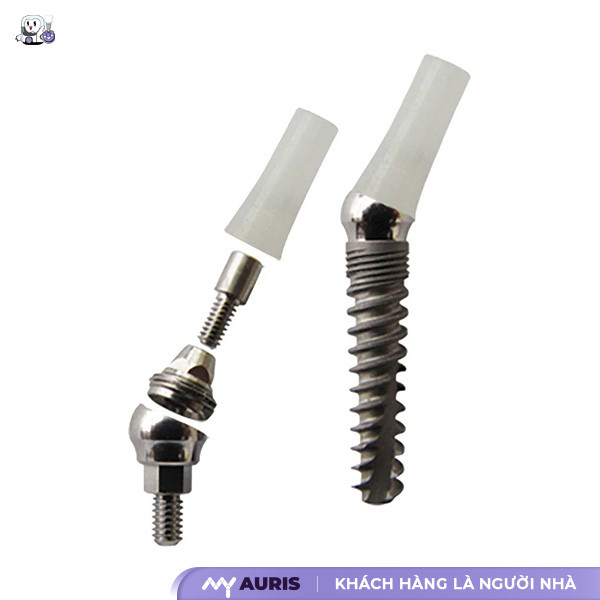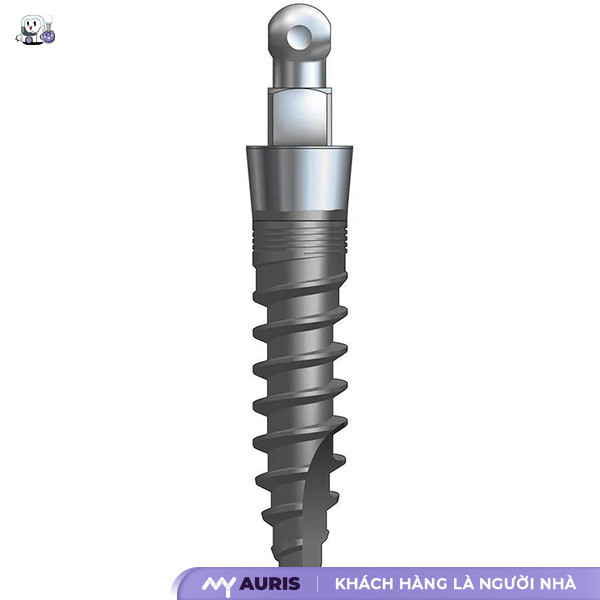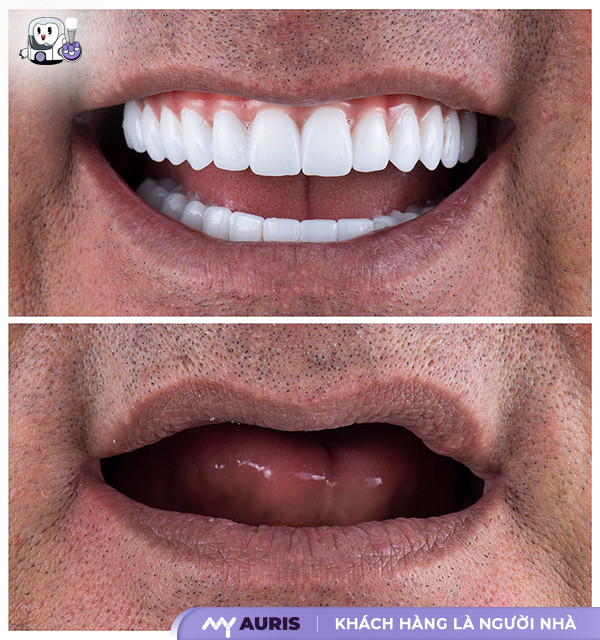Are you looking for an effective tooth replacement solution, an alternative to removable dentures or traditional dental bridges? Dental implant restoration is the optimal choice, providing a confident smile and chewing ability like natural teeth. This article by My Auris will meticulously analyze the structure and function of each component of a dental implant system, helping you better understand the implant placement process and make the best decision for tooth loss treatment.
Detailed Understanding of the Structure and Function of Dental Implant Components
The implant post acts as a tooth root, directly implanted into the jawbone. The material used is typically Grade 5 Titanium, known for its superior biocompatibility and ability to integrate directly with the jawbone. Implant post sizes and shapes vary, depending on the missing tooth’s location and the individual’s jawbone structure. Special micro-thread designs and antibacterial coatings help the implant post integrate quickly with the bone, ensuring high stability and longevity.
The abutment is an intermediate connector that connects the implant post to the prosthetic crown. This component has a diverse structure, including custom abutments and standard abutments. The material is typically Titanium or Zirconia. The abutment ensures the aesthetic and functional aspects of the dental restoration, allowing for flexible restoration. The abutment screw helps secure the abutment firmly onto the implant post, ensuring the stability of the entire implant structure.
The prosthetic crown is the part that replaces the tooth crown, made from porcelain crowns or other dental materials. Porcelain crowns offer a natural aesthetic like real teeth. The shape and color of the crown are designed to match the patient’s face and natural teeth. The prosthetic crown ensures good chewing force resistance, allowing you to eat and communicate comfortably.

Detailed Images and Diagrams of Dental Implant Structure
To better understand the implant structure, let’s look at detailed images and diagrams of the implant components: implant post, abutment, and crown:
Comparison of the Structure of Common Dental Implant Types
Traditional Dental Implant (Two-Part)
Traditional dental implants consist of two main parts: the implant post and the abutment connector. The implant post, made of Grade 5 Titanium, is implanted into the jawbone. The abutment connector links the implant post to the prosthetic crown. This dental material ensures superior biocompatibility. The two-part structure allows for flexible restoration. Traditional implants have advantages in terms of implant placement cost. However, the placement technique requires a sufficiently healthy jawbone.
Advantages:
- Reasonable implant placement cost
- Ability to integrate directly with the jawbone
- High durability and longevity
Disadvantages:
- Requires a sufficiently healthy jawbone
- Treatment time may be longer

One-Piece Dental Implant (Monoblock)
A one-piece dental implant integrates the implant post and abutment into a single unit. The material used is typically Grade 5 Titanium. This design simplifies the implant placement process. One-piece implants offer advantages in terms of treatment time. This type of implant is suitable for cases of missing primary teeth or wisdom teeth. However, the ability to adjust the restoration is more limited compared to two-piece implants.
Advantages:
- Simple implant placement procedure
- Short treatment time
- Suitable for certain tooth loss cases
Disadvantages:
- Limited adjustability of the restoration
- Implant placement cost may be higher

Mini Dental Implant (Small Diameter Implant)
Mini implants are smaller in size than traditional implants. Their shapes and connections are diverse. This type of implant is suitable for cases with thin, narrow jawbones. Mini implants are often used as supports for removable dentures or dental bridges. Advantages include less invasiveness and faster recovery time. However, mini implants have lower stability than traditional implants.
Advantages:
- Less invasive
- Faster recovery time
- Suitable for thin, narrow jawbones
Disadvantages:
- Lower stability

Overall comparison table of Implant types
| Feature | Traditional Implant | One-Piece Implant | Mini Implant |
| Structure | Two parts (post, abutment) | Monoblock | Small diameter |
| Material | Titanium grade 5 | Titanium grade 5 | Titanium |
| Size | Standard | Standard | Small |
| Advantages | High durability, flexible restoration | Simple procedure, short treatment time | Less invasive, fast recovery |
| Disadvantages | Requires healthy jawbone | Limited adjustability of restoration | Lower stability |
| Indications | Various dental implant restorations | Single tooth loss cases | Thin, narrow jawbones, removable dentures |
Understanding the Dental Implant Placement Procedure
Phase 1: Examination and Treatment Planning
The first step in the implant placement procedure is a general examination and X-ray imaging. The dentist assesses the condition of the jawbone, the missing tooth’s location, and overall health. Based on the results, the dentist will create a treatment plan, select the appropriate implant type, abutment, and crown, and determine the precise position for the implant post.
Phase 2: Implant Post Placement
After the planning is complete, the dentist proceeds to place the implant post into the jawbone. Placement screws are used to secure the implant post. In some cases, artificial bone membrane may be used to aid the osseointegration process. This process requires precise placement techniques to ensure the implant post is correctly positioned, stable, and integrates well with the jawbone.
Phase 3: Abutment Connection
Once the implant post has fully integrated with the jawbone (which usually takes several months), the dentist will connect the abutment. The abutment serves as a bridge between the implant post and the prosthetic crown. There are various types of abutments, including custom abutments, designed specifically for each case. Abutment screws are used to secure the abutment to the implant post. The abutment ensures the aesthetic and functional aspects of the artificial tooth.
Phase 4: Crown Placement
Finally, the prosthetic crown, typically a porcelain crown, is attached to the abutment. The crown is custom-made to match the color and shape of natural teeth, ensuring high aesthetics. Porcelain crowns have good chewing force resistance, allowing you to eat comfortably.

Dental Implant Manufacturing Materials and Properties
The implant post, the most crucial component, is typically made from Grade 5 Titanium. This dental material stands out for its superior biocompatibility, ability to integrate directly with the jawbone (jawbone foundation), and outstanding durability.
The abutment connector, which bridges the implant post and the prosthetic crown, can be made from Grade 5 Titanium or Zirconia. Custom abutments, designed specifically for each case, ensure aesthetics and precise occlusion.
Additionally, artificial bone membrane may be used in cases of jawbone deficiency. This material helps regenerate the jawbone foundation, creating favorable conditions for implant post placement. Placement screws, typically made from Titanium, are used to secure the implant post to the jawbone.

Factors Affecting the Durability and Longevity of Dental Implant Structures
Manufacturing materials play a crucial role in implant durability. Grade 5 Titanium, a common dental material, stands out for its superior biocompatibility and ability to integrate directly with the jawbone.
Placement technique and the dentist’s skill directly impact the initial stability and osseointegration process of the implant. A precise and technically correct implant placement procedure ensures the implant is firmly seated in the jawbone, minimizing complications.
Post-implant care is a determining factor for longevity. Proper oral hygiene helps prevent infections and maintain the health of soft tissues around the implant. Regular dental check-ups allow the dentist to examine, detect early issues, and intervene promptly.
Overall health influences the healing and osseointegration process after implant placement. Conditions like diabetes and osteoporosis can slow this process. Smoking is also a negative factor, affecting blood flow to the implant site and increasing the risk of infection. A balanced, nutrient-rich diet supports recovery and maintains overall oral health.
Choosing a reputable implant placement facility with an experienced dentist is the most important factor. Reputable dental centers use modern materials and equipment, ensuring a safe and effective placement procedure.
In summary, the durability and longevity of dental implant restorations depend on many factors, from materials and placement technique to post-placement care and overall health. Understanding these factors helps you actively protect your dental implant system, maintaining a healthy, confident smile for life. Do not hesitate to contact a dentist for specific advice on treating tooth loss with dental implant solutions.





